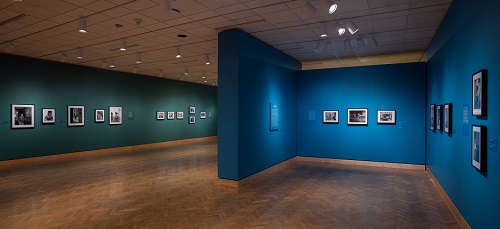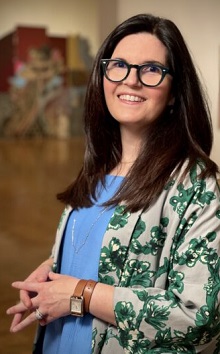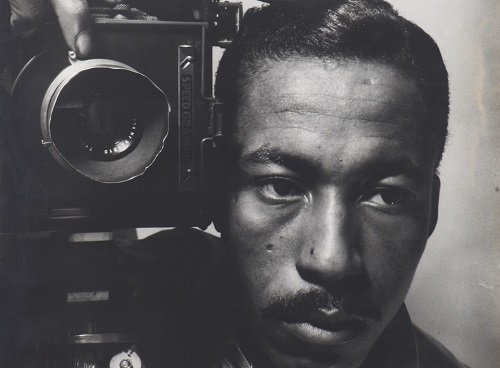New Mia Exhibit: American Gothic, Gordon Parks and Ella Watson
 Saturday, February 10, 2024 at 7:27AM |
Saturday, February 10, 2024 at 7:27AM |  Becky Fillinger |
Becky Fillinger | Article by Becky Fillinger, photos provided
A discussion with Casey Riley, PhD, Chair of Global Contemporary Art and Curator of Photography and New Media, Mia

Don’t miss this exhibit of Gordon Parks’ photographs of Ella Watson, taken in the early 1940s, at Mia until June 23, 2024. We talked to Casey Riley, who curated the show - she gave us historical background on Parks, his unique partnership with Ella Watson, and the enduring relevance of this series.
Q: For people unfamiliar with Gordon Parks and his work, can you provide a brief background on him and his significance in the world of photography?
 Dr. Casey RileyA: The Gordon Parks Foundation has a wealth of information on the artist, so please allow me to quote directly from their excellent biography on Parks, who as they note was not only one of the greatest photographers of the twentieth century, but also a humanitarian with a deep commitment to social justice. Parks’ photographic legacy is plainly evident in the exceptional body of work he created from the early 1940s into the 2000s, the contents of which document American life and culture by centering matters of race, poverty, civil rights, and urban life. Per the Foundation’s website, “Parks was also a distinguished composer, author, and filmmaker [he directed Shaft!] who interacted with many of the leading people of his era—from politicians and artists to athletes and celebrities.
Dr. Casey RileyA: The Gordon Parks Foundation has a wealth of information on the artist, so please allow me to quote directly from their excellent biography on Parks, who as they note was not only one of the greatest photographers of the twentieth century, but also a humanitarian with a deep commitment to social justice. Parks’ photographic legacy is plainly evident in the exceptional body of work he created from the early 1940s into the 2000s, the contents of which document American life and culture by centering matters of race, poverty, civil rights, and urban life. Per the Foundation’s website, “Parks was also a distinguished composer, author, and filmmaker [he directed Shaft!] who interacted with many of the leading people of his era—from politicians and artists to athletes and celebrities.
Born into poverty and segregation in Fort Scott, Kansas, in 1912, Parks was drawn to photography as a young man when he saw images of migrant workers taken by Farm Security Administration (FSA) photographers in a magazine. After buying a camera at a pawnshop, he taught himself how to use it. Despite his lack of professional training, he won the Julius Rosenwald Fellowship in 1942; this led to a position with the photography section of the FSA in Washington, D.C., and, later, the Office of War Information (OWI). Working for these agencies, which were then chronicling the nation’s social conditions, Parks quickly developed a personal style that would make him among the most celebrated photographers of his era. His extraordinary pictures allowed him to break the color line in professional photography while he created remarkably expressive images that consistently explored the social and economic impact of poverty, racism, and other forms of discrimination.”
Q: Please tell us about the unique collaboration between Gordon Parks and Ella Watson.
A: When Parks arrived in Washington, D.C. to work with Roy Stryker in the Historical Section of the Farm Security Administration, he was eager to document the community as he had done in Chicago. What he did not anticipate were the challenges he would face as a Black man in the nation’s capital, where racial segregation and discrimination were commonplace. Knowing the situation all too well, Stryker suggested that Parks begin by exploring Washington without his camera. Unfortunately, Parks found bigotry everywhere. He was turned away by restaurants, kicked out of theaters, and denied service at a respected department store where he attempted to buy a winter coat. Parks was crushed–and filled with righteous anger. “In this radiant, historic place,” he lamented, “racism was rampant” (Half Past Autumn, 1997).
 Gordon Parks, Self-Portrait (detail), 1941, gelatin silver print. Courtesy of The Gordon Parks Foundation. Taken at age 28, when Parks was living in Chicago.
Gordon Parks, Self-Portrait (detail), 1941, gelatin silver print. Courtesy of The Gordon Parks Foundation. Taken at age 28, when Parks was living in Chicago.
To his credit, Parks channeled his disillusionment into creative potential. He returned to FSA headquarters, where Stryker recommended that he begin his project closer to home. Upon leaving Stryker’s office, Parks approached the Black woman who was cleaning the hallway outside. Her name was Ella Watson, and their conversation about her life story riveted him. Parks eventually asked if he could take Watson’s picture. She agreed, and for several weeks afterward gave him primary access to her everyday life: at home, at church, and in her neighborhood. The resulting photographs–about 90 in all, of which we selected 59 for the exhibition at Mia–reveal the depth and breadth of Watson’s experiences and commitments as the matriarch of a household that included four children, a church deaconess, and a Federal employee. It’s a multifaceted portrait that reveals much more than the difficulties of her life, which were many; she emerges as a central figure in the life of that city, and of the nation.
Q: Roy Stryker of the Farm Security Administration thought American Gothic was an indictment of America and could lead to the firing of all the photographers on staff. However, he encouraged Parks to continue photographing Watson. When was this body of work published? What was the reaction from the public?
A: That’s correct. When Parks showed "American Gothic" to Stryker, he was warned that its publication could cost them their jobs. Since the FSA was a government agency, and needed to maintain a certain editorial distance from subjects that could be seen as “political,” Stryker felt that the image was too provocative for the congressmen who funded the agency. Despite being taken in 1942, the photo remained unpublished until 1948, when Parks became the first Black staff photographer at LIFE magazine. The portrait became famous only in the 1960s, when many people were ready to accept its commentary on American racism.
Q: In what ways do you believe Gordon Parks' work remains relevant in contemporary society?
A: Gordon Parks' legacy extends across American visual culture - his work has inspired many contemporary artists, including Hank Willis Thomas, who contributed to the publication accompanying the show. As an artist who cared deeply about social justice and devoted his practice to it, his work resonates deeply with contemporary audiences.
Q: Will Mia provide educational programs or tours for this exhibition?
A: Absolutely – we are honored to host this work in Minneapolis, and to have partnered with the amazing folks at the Gordon Parks Foundation to realize this project. In terms of programming, and to complement the exhibition, celebrated photographer LaToya Ruby Frazer will share her perspective on Gordon Parks and Ella Watson in conversation with me on Wednesday, March 14, in a program that is co-sponsored by Mia’s Friends of the Institute. Philip Brookman and I co-edited the publication that accompanies the show; you can purchase advance copies from the Store at Mia!
Q: How may we follow news about Gordon Parks' creative life?
A: I think the best resource is The Gordon Parks Foundation to stay up to date on his life and legacy.
